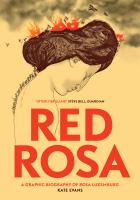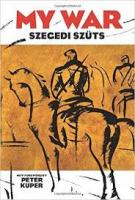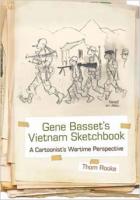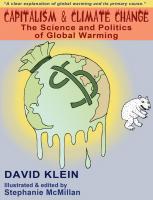
Red Rosa: A Graphic Biography of Rosa Luxemburg, Kate Evans, Verso, 2015, paperback, $16.95
Capitalism and Climate Change: The Science and Politics of Global Warming, David Klein (author) and Stephanie McMillan (editor and illustrator), Amazon digital services, 2015, eBook, $2.95
Gene Basset’s Vietnam Sketchbook: A Cartoonist’s Wartime Perspective, Thom Rooke, Syracuse University Press, 2015, paperback, $24.95
My War, Szegedi Szüts, Dover, 2015, paperback, $12.95
The graphic lit juggernaut rolls on. Even as DC and Marvel crank out superhero comics at roughly the same pace they have for the past twenty or thirty years, trade publishers and university presses are issuing nonfiction narrative art on a scale that would have been unthinkable a decade ago. Back in the day, the four books under review would have represented a significant percentage of like-minded cartooning to appear in any given season. Now practically every publishing house under the sun boasts a new graphic novel line or at very least a fistful of titles aimed at the words-and-pictures market.
For many NP readers the title that most likely jumps out here is Kate Evans’ new biography of Rosa Luxemburg, which cleverly encapsulates Luxemburg’s life and work in a way that is both substantive and accessible. Even those who are well versed in the history of early twentieth century socialism will be struck by the clarity of Evans’ prose as well as her page compositions, which trace Luxemburg’s development from her childhood in Poland to her emergence as a famous intellectual and political figure, one whose writings on economics, imperialism, and political organization remain relevant even today. Evans’ account pays close attention to the social milieu within which Luxemburg operated, along with the political debates that she took part in. I was especially impressed by her presentation of her (and Marx’s) ideas about commodities, class relations, and the contradictions of capitalism. Her book also does a fine job of conveying Luxemburg’s wry sense of humor and her love of the natural world.
As the political cartoonist Tim Sanders pointed out in his review of Red Rosa for the UK journal Socialist Review,
Evans takes us on a journey through the revolutionary’s career, focusing not just on politics but also on her personal life and loves. Even her pet cats are graphically brought to life in Evans’ vivid illustrations. We get a strong sense of Luxemburg as a real rounded human being rather than a collection of her political stances, though the historical notes at the back of the book make for fascinating reading too.
(Sanders himself was profiled in a Words & Pictures feature in NP #52.)
The specter of conflict hangs over the entire narrative, from the threats that Jewish families like Luxemburg’s faced in late nineteenth-century Poland, and the horrific blood letting of the First World War, to the democratic class war she advocated in her journalism and at public rallies. There is scarcely a page in which warfare in one guise or another is not threatened or invoked. Indeed, the cover image is taken a two-page spread in which Rosa Luxemburg’s neck and head are filled with miniature soldiers, explosions, and dead bodies. On the page that follows the spread, Evans reproduces a stirring passage from Luxemburg’s “The Junius Pamphlet” (1916):
Into the disillusioned atmosphere of pale daylight there rings a different chorus; the hoarse croak of the hawks and hyenas of the battlefield. Ten thousand tents, guaranteed according to specifications, 100,000 kilos of bacon, cocoa powder, coffee substitute – cash on immediate delivery. Shrapnel, drills, ammunition bags, marriage bureaus for war widows, leather belts – only serious propositions considered. And the cannon fodder that was loaded onto the trains in August and September is rotting on the battlefields of Belgium and Vosges, while profits are springing, like weeds, from the fields of the dead.

Not surprisingly, war is also the central theme of Szegedi Szüts’ My War, which was first published in 1931 and which Dover has just now reissued in a handsome edition that features a new foreword by Peter Kuper (see NP #36). István Szegedi Szüts (1893-1959) was a Hungarian painter and illustrator who saw combat during World War I and settled in Cornwall in the 1930s. His “wordless novel” consists of 206 drawings that were originally exhibited in London to critical acclaim. Dover recently announced plans to issue twelve graphic novels and nonfiction titles a year, with an emphasis on out-of-print books. If My War is any indication it is a promising development.
Both My War and Red Rosa are filled with sometimes rousing and sometimes horrifying depictions of political and military campaigns from a century ago. But the two books are quite distinct from an aesthetic perspective. Whereas Kate Evans’ pages carefully record period details, from living rooms to military uniforms, Szüts favors a spare approach in which white space is interrupted by sudden outbursts of black ink. Evans’ characters are garrulous, and many of her pages are organized around conversations, classroom lectures, and soapbox speeches. By contrast, Szüts eschews formal language and uses thick brushstrokes to trace the protagonist’s journey from civilian life to the battlefield.
The two books share an antipathy to nationalist rhetoric and mass warfare, and end on a similarly tragic note that – spoiler alert – involves the state-sanctioned murder of their main characters. Neither offers a conventional happy ending, but Szüts’ final pages are purely melancholic while Evans’ conclusion is guardedly optimistic. More specifically, her book’s afterword notes that, with the “crushing of the Hungarian Rebellion and Russian leader Nikita Khrushchev’s own repudiation of Stalin at the Soviet Congress of 1956, Rosa’s reputation was bound to revive.” This “process of popular recognition,” she suggests,
has continued with the emergence of still younger generations into the twenty-first century, perhaps tied most of all to the anti-austerity movements sweeping many parts of the globe. Rosa’s insistence that the expansion of Empire is at once the salvation of capitalism and doom for the planet is an ecological insight of ever-greater value for radicals drawn to her ideas and example.

The stance adopted by Gene Basset in his Vietnam Sketchbook is neither as mordant as Szüts’ nor as politically engaged as Evans’. Gene Basset (1927-) is a retired U.S. newspaper cartoonist who spent much of his career working for the Scripps Howard News Service and, subsequently, the Atlanta Journal Constitution. In 1965 a news editor at Scripps Howard came up with the idea of sending a cartoonist – Basset – to South Vietnam to cover the war, which at that point was starting to escalate. He ended up spending three months “in country,” dividing his time between Saigon, military bases, and patrolling with U.S. soldiers. Basset tended to sketch whatever he came across, from farmers’ markets and motorized rickshaws to fishing boats and medical clinics. Many years later, Basset showed some of these long-forgotten drawings to his friend Thom Rooke, a professor of medicine at the Mayo Clinic. Rooke was so impressed that he “hung some on the walls of my house as decorative art,” and put together this collection of nearly 90 cartoons, most of them wordless.
Rooke’s involvement in this project has its pluses and minuses. On the debit side, he carries a somewhat inflated sense of himself as a dispassionate observer of reality. “By missing the war,” he loftily claims at the start of the book, “I was left with a relatively unbiased perspective, one that has allowed me to look back at it – almost half a century later – with a genuine objectiveness that remains impossible for many of my peers.” Having emphasized his powers of objectivity, Rooke then tallies up the “consequences” of the war, but from an entirely U.S.-centric perspective, as if the Vietnamese people themselves were not a factor. While his breezy introduction does little to illuminate the causes or trajectory of the Vietnam War, it does provide interesting details about Gene Basset’s career as an editorial cartoonist, which more or less coincided with the heyday of newspaper cartooning as a full-time profession. Rooke additionally had the editorial inspiration to organize Basset’s drawings around Kubler-Ross’ famous five stages of grief – denial, anger, bargaining, depression, and acceptance. These categories lend a sense of narrative sequence, and a touch of pathos, to Basset’s sometimes cryptic and guarded pen-and-ink images, which are closely observed but not always easy to decipher.
The differences between the artistic styles in these books are interesting. Kate Evans’ pages exude a kind of quirky indie-comics energy. They spotlight Berlin street scenes, lovers’ quarrels, and larger-than-life personalities – Karl Kautsky, Eduard Bernstein, Clara Zetkin, and Karl Liebknecht, for example. Szüts’ pages, on the other hand, are graceful, austere, and technically accomplished. They usually focus on a single visual element – a tree, a face, a corpse. As Kuper writes in his foreword, Szüts’ “work seamlessly moves from lyrical images that would sit comfortably on your grandmother’s dining room wall, to gritty portraits of wounded and dying soldiers that could hang boldly in a museum setting next to Otto Dix, George Grosz, Käthe Kollwitz, and Francisco Goya’s series of etchings, Disasters of War.”
Gene Basset’s drawings are in an altogether different register – the linework is loose, almost rubbery. Some of his pieces seem light-hearted, or merely descriptive. Others brim with subtext, especially the ones that portray Americans and Vietnamese interacting, either on the streets of the country’s capital city or on training exercises that Basset was invited to observe. There are several knockouts, including a drawing titled “Fatal Fire Fight,” which he drew after a Green Beret patrol that he was attached to came under fire. “I ducked behind a rock as the Montagnard in front of me was hit in the head and the Green Beret was hit in the legs…My sketchbook took a bullet during the fight,” he later remembered. Basset’s depictions of Saigon’s black market are also highly evocative, and more than a little disturbing. While I would not go so far as to describe these illustrations as antiwar, they are indicative of a sensibility that was becoming increasingly disenchanted with the war effort, and perhaps to some extent with the American way of life itself.

If Gene Basset’s Vietnam Sketchbook exhibits signs of political dissatisfaction, Capitalism and Climate Change is all about revolutionary change. In the book’s forward, Stephanie McMillan argues that, “capitalism and a healthy planet are totally incompatible.” The “struggle against ecocide,” she says, “is an integral part of class struggle. It can only be won in the context of the fundamental struggle of the working class against exploitation, for emancipation, for the demise of capitalism.” While McMillan is an activist, writer, and cartoonist, David Klein is a professor of mathematics at California State University, Northridge. He shares McMillan’s anti-capitalist ideology but provides the empirical data, scientific terminology, and secondary sources to help readers make sense of the connection between carbon emissions and global economics. His text is organized around two sections, “What Does Climate Science Tell Us?” and “Why Capitalism Cannot Solve the Climate Crisis.” The first is should prove especially helpful for anyone who remains put off by the technical jargon and who seeks a lucid explanation for why so many experts in the field are themselves starting to consider radical alternatives to mainstream approaches and paradigms. The clarity of Klein’s prose is nicely complemented by McMillan’s appealing single-panel cartoons, which utilize zany colors, humorous figuration, and biting one-liners. There are other graphic books about climate change out there, such as Philippe Squarzoni’s Climate Changed: A Personal Journey Through the Science (2014), but this affordable eBook does the best job so far of looking at contemporary climate science via from a broadly Marxist perspective.
Kent Worcester's latest book is Peter Kuper: Conversations (2016).


RED ROSA is a must-read!
Check out Kate Evans’ website, with a RED ROSA preview:
http://www.cartoonkate.co.uk/red-rosa/